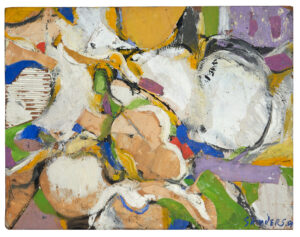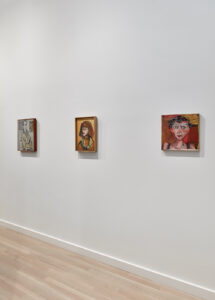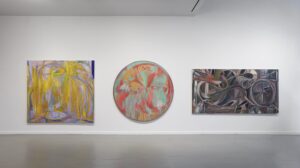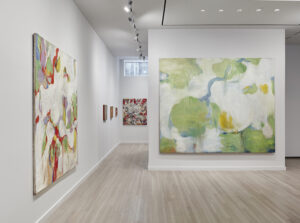Joop Sanders: The Last Abstract Expressionist | The Brooklyn Rail
by Ekin Erkan
Milton Resnick and Pat Passlof Foundation March 7–July 19, 2025
New York

Joop Sanders, The Game, 1959. Collage, 17 1/2 × 24 inches. © Joop Sanders Testamentary Trust. Courtesy Milton Resnick and Pat Passlof Foundation.
The Milton Resnick and Pat Passlof Foundation’s Joop Sanders: The Last Abstract Expressionist, curated by Isca Greenfield-Sanders and Peter Halley, evinces the history of twentieth-century American abstraction through Sanders’s artistic development. It is bookended, on the one hand, by an Abstract Expressionism characterized by dense brushwork and interpenetrating, fragmented forms and, on the other, by flattened, hard-edge geometry. Sanders’s early paintings reveal the formative influence of Willem de Kooning’s method of compositional “massing and packing,” as Stephen Polcari describes it in Abstract Expressionism and the Modern Experience (1991). As the exhibition proceeds chronologically, one is privy to how over the course of the sixties Sanders comes into his own, focusing on the color interaction of semi-enclosed geometric shapes.
The exhibition’s curatorial choices indicate the determinative role de Kooning played in Sanders’s early career. After Elaine de Kooning introduced the two Dutchmen in the early forties, the duo took on the relationship of student and teacher. Cathy Curtis tells us in A Generous Vision: The Creative Life of Elaine de Kooning (2017) that during the mid-forties, the de Koonings and Sanders would sit for one another, with Elaine taking particular interest in the contours of Sanders’s facial expressions, which tended to shift “from an aloof stare to an unfocused brooding.” Included in the show alongside a 1955 portrait of Sanders’s wife, Isca, is Elaine de Kooning’s portrait, Joop-Angel #3 (1945), which fixates on Sanders’s angular jawline and delicate features. Sanders’s own portrait of an impressionistically rendered Elaine from 1945 is the earliest work by him in the show.
However, the earliest abstract works on view are three collages and an oil on canvas, Black Witch, all from 1957. In Black Witch, we encounter a painterly flux of rectilinear fragmented forms and speeding impressions —the influence of de Kooning’s paintings of the early-to-mid fifties, such as the iconic Excavation (1950), is clear. Striated carmine crashes into soot-edged flaxen forms and eggshell white vignettes tear into painterly shards. Here, and in other works by Sanders from the late forties, we find glimpses of what de Kooning termed the “no-environment,” where continuous brushwork flutters allude to Manhattan’s bustling squalor. In Sanders’s suite of three 1957 collages, Again, There Is a Happy Land, and an untitled work, we can espy another de Kooning technique: the affixing of newspaper headlines onto the canvas. As Polcari observes, de Kooning utilized this for both pragmatic and aesthetic reasons: to slow drying and because when removed they left a “ghostly imprint” of text. Similar rectangles of newspaper print are stamped between Sanders’s eclipsing blocks and planes.

Installation view: Joop Sanders: The Last Abstract Expressionist, Milton Resnick and Pat Passlof Foundation, New York, 2025. Courtesy Milton Resnick and Pat Passlof Foundation.
As the exhibition continues, we find Sanders contracting his disconnected swaths of paint throughout the late fifties. He introduces contrasting colorist interruptions and a Cubist grid to the all-over spread. For instance, in the upper-right corner of Sanders’s The Game (1959), thick lilac and mauve strokes flurry over cardboard ridges. In The Lake, Persian, and an untitled work (all 1959), glassy tufts of semi-translucent alabaster are edged with cherry bands and clouded jade clusters. Of this suite of works, Sanders’s large-scale oil-on-canvas, The Lake proves the most effective in its ability to hold pictorial space, its balanced viridian shrouds breaking through a white fog blanket dotted by two yolk-yellow breakaway bulbs. A lone petal-like orb of pale green swoops into the lower-left corner, strung from the upper edges by an azure ligature. The work suggests (though only suggests) naturalism dissolved into a fluid painterly flow.

Installation view: Joop Sanders: The Last Abstract Expressionist, Milton Resnick and Pat Passlof Foundation, New York, 2025. Courtesy Milton Resnick and Pat Passlof Foundation.
Admittedly, it is not in these earlier works—which often find Sanders following the example of de Kooning’s synthesis of Cubist infrastructure and Expressionist facture, Gerome Kamrowski’s biomorphism, and Mark Rothko’s rugged color fields—where Sanders reached his most impressive painterly heights. In the next decade, however, Sanders significantly developed as a painter, evidenced by the amber Summer Heat (1962) and navy Night Journey (1962). Here Sanders began working along a unified flat plane and with a single color. Following this advance into monochromatism, Sanders soon hardened the edges of his forms. This is when he truly matured as a painter. In Kronos (1965), Dutch Bride (1965), and God Save the Queen (1968) Sanders’s shapes are outlined by the surrounding negative space. Amid colliding pinwheel arcs and overlapping slatted circles, clean-cut linear forms became more identifiable. Having refined his formal language, Sanders soon reintroduced mixed palettes. In the blue-yellow complementary harmony of Dutch Bride, a distended white arc extends across golden and azure background blocks. The six-panel God Save the Queen—so titled due to the work’s repurposing of the palette of the Union Jack—scatters tapered oblique forms into a pleasingly tense configuration.

Installation view: Joop Sanders: The Last Abstract Expressionist, Milton Resnick and Pat Passlof Foundation, New York, 2025. Courtesy Milton Resnick and Pat Passlof Foundation.
The most impressive work in the exhibition is Vibrations (1968), one of Sanders’s “sectionals”—works whose final arrangement is left open to the curator. There are several very accomplished later works as well, including a swirling lime-and-vermillion motley tondo, Dream of the Red Chamber (1981–82), and Wheel of Fortune (1985), a large rectangular canvas of bronze centrifugal forms that resemble undulating pistons and axes. These are well executed and reveal a concentrated interest in circular forms. But it is in Vibrations where Sanders reaches his zenith. Eight panels are assembled as four spaced out pairs, each tower’s façade standing edge-to-edge such that their vertices protrude towards the viewer. The panels’ faces map rolling azure and mustard undulations along their vertical axes. This three-dimensional columnar installation brackets four square canvases hung on the back wall and exactingly arranged into a diamond. Each quadrilateral’s blue center is bordered by the same mustard yellow as the anta-like posts, sustaining a pleasing chromatic quality across the entire work. In a statement accompanying his October 1962 solo show at Bertha Schaefer Gallery, Sanders wrote:
Through the last six or seven years I have coped with the problem of simplifying my forms while intensifying their impact and adding to the significance of the painting as a whole…. The forms that are used have not basically changed from the older, more expressionistic canvases. The spatial concept is quite different, however, through the use of a modulating monochromatic field. The forms have all achieved equal importance in adding to the direct impact of the total image.
Sanders’s telos was this simplification of form, which reached its crescendo in his multi-canvas arrangement, Vibrations. Although the ever-protean artist did not remain fixed to any one mode, The Last Abstract Expressionist demonstrates Sanders’s cultivation of an intuitive sense for “modulating” forms—a compositional dexterity that is made clearly manifest by his mature hard-edge abstractions.
Ekin Erkan is a writer, curator, and researcher whose writing has appeared in the Journal of Value Inquiry, the International Journal of Philosophical Studies, and Hyperallergic, among others.
